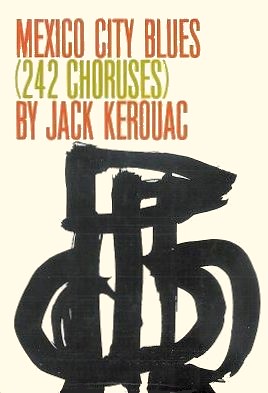Our final reading from Jack Kerouac will continue on themes and locations present in On the Road and The Subterraneans, and also serve as a transition from prose (albeit highly poetic prose) to poetry, setting us up nicely for two weeks exploring the work of Allen Ginsberg.
While Kerouac's long prose excursions were largely the products of time spent in recollection at the end of his journeys (after all, a typewriter and long rolls of teletype paper aren't that easy to drag along the road), his poetry was rooted in a spontaneous, portable materiality, crafted in the moment of inspiration, out in the world. He explains his poetics thusly:
In my system, the form of blues choruses is limited by the small page of the breastpocket notebook in which they are written, like the form of a set number of bars in a jazz blues chorus, and so sometimes the word-meaning can carry harmonically from one chorus into another, or not, just like the phrase-meaning can carry harmonically from one chorus to the other, or not, in jazz, the form is determined by time, and by the musicians' spontaneous phrasing & harmonizing with the beat of the time as it waves & waves on by in measured choruses.
It's all gotta be non stop ad libbing within each chorus, or the gig is shot.
Though divided into 242 choruses, Mexico City Blues is, Kerouac tells us, essentially one long interrupted poem, and we'll keep that in mind as we work through it. Also, as Kerouac notes above, while many of the poems can stand alone, there are many instances where several run together to form a longer train of thought. One example is Choruses 239-241, which Kerouac performed under the title "Charlie Parker" on his 1959 album (with Steve Allen on piano), Poetry for the Beat Generation:
Here are a few other settings of Mexico City Blues poems from that album:
221st Chorus, "Deadbelly"
149th Chorus, "One Mother"
Choruses 80-83, "Goofing at the Table"
211th Chorus, "The Wheel of the Quivering Meat Conception"
104th Chorus, "I'd Rather Be Thin Than Famous"
One person on whom Kerouac's work, and Mexico City Blues in particular, made a great impression (along with the work of Ginsberg and Burroughs) is Bob Dylan, as evidenced by this passage from Sean Wilentz's Bob Dylan in America, published in The New Yorker:
Dylan knew the poems, Ginsberg later claimed. “Someone handed me Mexico City Blues in St. Paul in 1959,” Dylan told him. “It blew my mind.” It was the first poetry he’d read that spoke his own American language, Dylan said — or so Ginsberg said he said. Maybe, maybe not. Without question, though, Dylan read Mexico City Blues and was deeply interested in Beat writing before he left Minneapolis for New York. (Like other Beats and hipsters, his friend Tony Glover ordered a paperback copy of William Burroughs’s Naked Lunch from France, where it had been published by Olympia Press in Paris in 1959 as The Naked Lunch — uncertain whether the book, deemed obscene by American authorities, would clear customs. The book indeed arrived, and Glover lent it to Dylan, who returned it after a couple of weeks.) And Dylan’s involvement with the writings of Kerouac, Ginsberg, Burroughs, and the rest of the Beat generation is nearly as essential to Dylan’s biography as his immersion in rock and roll, rhythm and blues, and then Woody Guthrie. “I came out of the wilderness and just naturally fell in with the Beat scene, the bohemian, Be Bop crowd, it was all pretty much connected,” Dylan said in 1985. “It was Jack Kerouac, Ginsberg, Corso, Ferlinghetti … I got in at the tail end of that and it was magic … it had just as big an impact on me as Elvis Presley.”[note: the entire piece merits reading]
We'll be covering Mexico City Blues in two classes, with several student presentations, each covering one chorus or group of choruses. Put on some jazz, indulge in the intoxicant of your choice (nicotine, caffeine, etc.) and enjoy the unbridled flow of language. Better yet, read them out loud and freak out your roommates — these are made to be heard, not just read!
Here's the breakdown:
- Tuesday, Feb. 1st: Choruses 1-148 // presentations by Taylor Panning & Sarah Gullion
- Thursday, Feb. 3rd: Choruses 149-242 [no presentations, but if someone who hasn't signed up for a presentation wants to present, that's great — e-mail me]
Here are a few additional links and videos for your perusal:
Ginsberg and Dylan read from Mexico City Blues at Kerouac's grave (as mentioned in the Wilentz essay)
Johnny Depp performs the 113th Chorus (in a delightfully dated video)

No comments:
Post a Comment